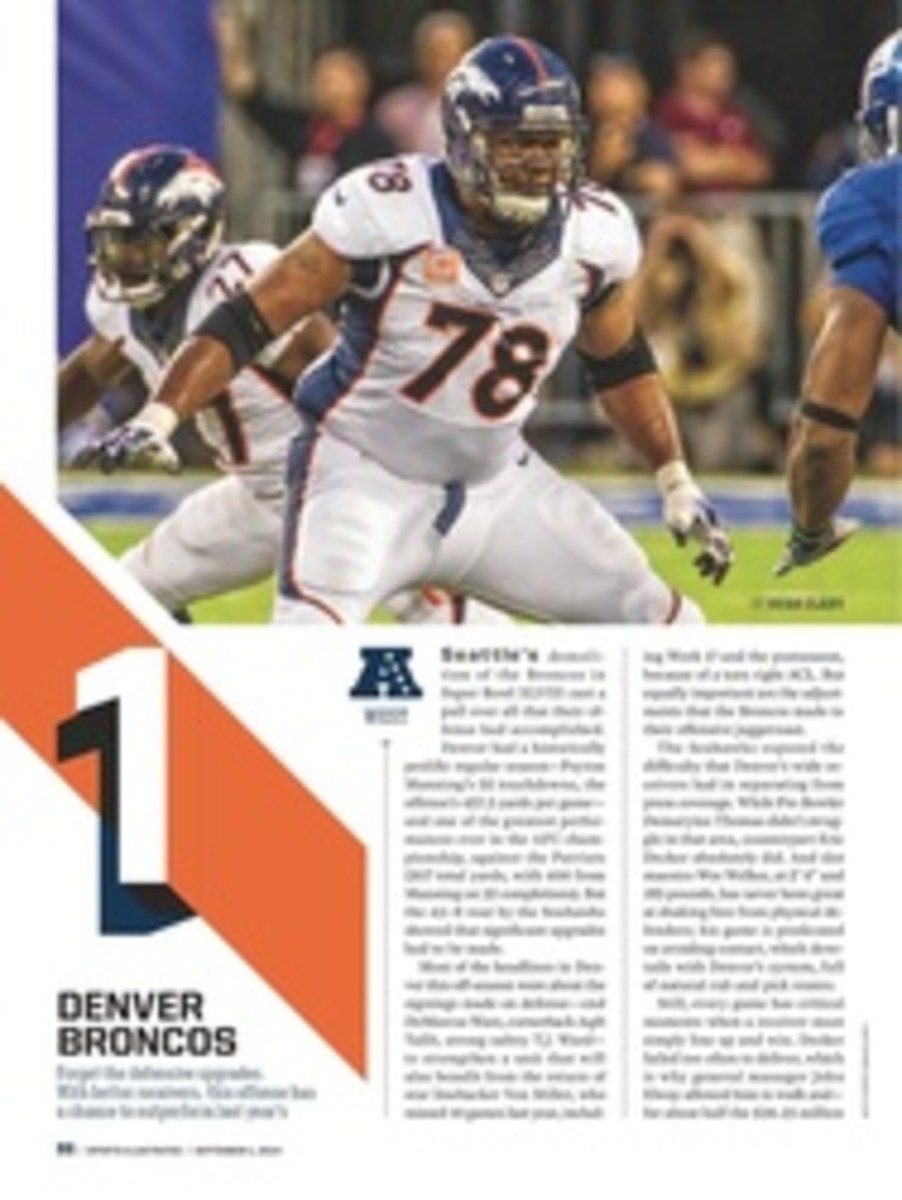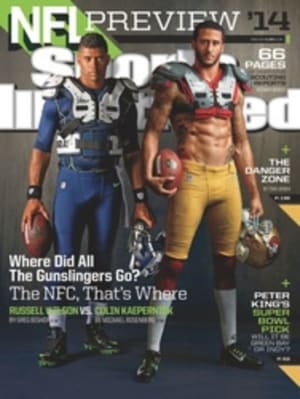
4 DALLAS COWBOYS
We've seen the future of the NFL offense, and it looks a lot like the 2013 Cowboys'. More times than any team except the Cardinals last year, Dallas lined up in a 3 √ó 2 empty set, with three pass catchers to one side, two to the other and nobody but the quarterback in the backfield. Most offenses use this formation to add dimension to the standard three-wideout personnel, with the running back flexing out. The idea: Catch a defense off guard or create a one-on-one mismatch (or both). But the Cowboys' empty sets, often featuring one tight end and four wide receivers, made clear their aerial intentions.
The advantages of a 3 √ó 2 empty are straightforward. When an offense spreads out, so does the defense, making coverages tough to disguise and creating bigger gaps in the zones. Most defenses respond by using pure man-to-man, which enables the offense to run more pick routes and creates more favorable mismatches. It also more clearly defines the coverage for the quarterback, who can make key decisions presnap as opposed to when the heat is on.
All of this plays to the strengths of Tony Romo; it's likely no coincidence that Dallas's increase in spread sets came in the same year, 2013, that he assumed a greater role in his team's game planning. Romo is fairly acute before the snap. But after it he's a so-so decision maker with a tendency to get fooled by trap coverages, which defenses tend to unleash against him in crucial fourth-quarter moments.
To help Romo, the Cowboys essentially demoted offensive coordinator Bill Callahan, who'll now focus on the running game and the O-line, and brought in passing-game coordinator Scott Linehan to call plays. Recall that before last season, coach Jason Garrett was the play-caller. Jerry Jones changed that.
To be clear, Linehan wasn't hired to redefine this offense; his aim is to bring more continuity to the play-calling and sharpen some of the route designs. Before Dallas he spent five years in Detroit crafting plays around a superstar receiver, Calvin Johnson, who almost always influenced opponents' coverages. With the Cowboys, Linehan has a similar weapon in double-team magnet Dez Bryant.
What Linehan didn't have with the Lions is a tight end who commands double teams. At 32, Jason Witten remains as potent as ever, thanks largely to a playing style that's not dependent on speed. Instead, he excels at making contested catches, especially at the shallow intermediate levels, providing Romo with a security blanket and giving Linehan another weapon to build around.
Linehan has never been zealous about the ground game, but he will need to find more balance between the pass and run calls. The Cowboys have an outstanding ballcarrier in DeMarco Murray—if he stays healthy. Murray missed three games as a rookie in 2011 (right ankle), six games in '12 (left foot) and two games last season (left MCL). He's a strong downhill runner who, though stiff in the hips, can muster just enough wiggle to create spaces and break tackles. Murray's 5.2 yards per carry last year ranked third among running backs with at least 100 attempts.
If Murray is out, reserve backs Lance Dunbar and Joseph Randle can still be productive, thanks to what could evolve into the league's most dominant offensive line. This unit is built not for power (like Dallas's Great Wall of the early 1990s) but for movement. Insanely athletic left tackle Tyron Smith, for one, is ascending at a rate that could make him the NFL's best lineman by season's end. Center Travis Frederick (whom many pundits thought the Cowboys drafted too early, late in the first round last year, but who was named to the NFL's All-Rookie Team) has terrific initial quickness, allowing him to execute "reach and seal" blocks against defenders inside—vital on zone-running plays. Joining Frederick inside are the slow-twitched Ronald Leary and this year's first-round pick, Zack Martin (Notre Dame), who the team expects will immediately correct a glaring weakness at right guard. And at right tackle Doug Free seems to have recaptured his big-money form after two down years forced him into a pay cut before 2013.
The pieces are in place for an extraordinary offense. And considering that the Cowboys' defense is painfully undermanned, that's what they'll need if they're to finish better than .500 for the first time since 2010.
2014 SCHEDULE
2013 Record: 8--8
WEEK 1
SF [HOME]
TEN [AWAY]
STL [AWAY]
NO [HOME]
HOU [HOME]
SEA [AWAY]
NYG [HOME]
WAS MON [HOME]
ARI [HOME]
JAX LONDON
BYE
NYG [AWAY]
PHI THUR [HOME]
CHI THUR [AWAY]
PHI [AWAY]
IND [HOME]
WAS [AWAY]
WEEK 17
MAJOR CONCERN
The defensive front
After a brutal rash of injuries last year, the Cowboys' D suffered even deeper losses during the off-season when future Hall of Famer DeMarcus Ware signed with the Broncos and Pro Bowl tackle Jason Hatcher joined Washington. The football gods delivered another blow when star middle linebacker Sean Lee tore his ACL in May OTAs. There's no viable option to replace Lee. To fill the voids on the line, Dallas traded up to draft pass rusher Demarcus Lawrence (Boise State) with the 34th pick and signed former Pro Bowl defensive tackle Henry Melton. Both have injury concerns. Lawrence missed virtually all of training camp with a broken foot and will begin the season on the shelf. Melton battled a groin injury in camp after missing 13 games in 2013 with a left ACL tear. (If his knee looked promising this off-season, wouldn't Chicago have re-signed him?) Downgrading at defensive end and tackle wouldn't be so bad except that the rest of Dallas's front seven is composed of makeshift players.
THE CASE FOR
Cornerback Brandon Carr
The former Chief received roughly $14 million last year as part of a five-year, $50 million contract. Aside from a little trouble playing with outside leverage against top receivers, Carr fully justified the signing—but he'll have to perform even better in 2014. New defensive coordinator Rod Marinelli is going to ramp up the man coverage. Last season the Cowboys used Monte Kiffin's zone-based Cover Three scheme—a modernized version of the dying Cover Two—and by Week 15 they'd yielded the most yards in franchise history. Kiffin went with more zones because he wanted defenders to have their eyes on the ball and to create more turnovers. That worked. After causing just 16 turnovers in Rob Ryan's man-based scheme in '12, Dallas forced 28 in '13. With this in mind, Marinelli will probably use firm man coverage only on the outside. Inside, he'll stick with zone, mimicking the scheme that has worked for the Seahawks. While the Cowboys' resources are nowhere near Seattle's, they do have at least one qualified press corner in Carr, who plays bigger than his actual size and knows how to be physical.
PHOTO
KYLE RIVAS/GETTY IMAGES
RB DEMARCO MURRAY
PHOTO
ROBERT HANASHIRO/USA TODAY SPORTS
NINTEEN PHOTOS

